#subject: judith beheading holofernes
Text
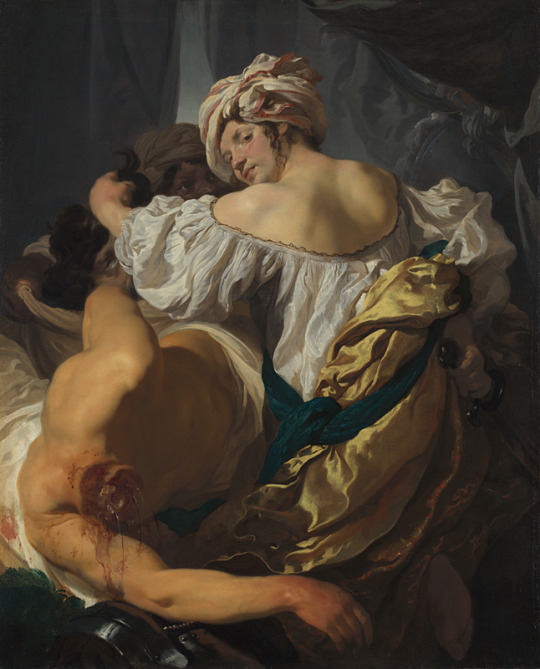
Judith in the Tent of Holofernes, c. 1622
Johann Liss (c. 1595 - 1631)
#artist: johann liss#movement: baroque#medium: oil on canvas#medium: oil#genre: biblical#subject: judith beheading holofernes#era: 17th century#locale: venice#nationality: german
6 notes
·
View notes
Text

Artemisia Gentileschi (1593 c. 1656): Judith Beheading Holofernes, 1611, oil on canvas, 158,8 x 125,5 cm, Museo Nazionale di Capodimonte, Naples.
Artemisia Gentileschi (c. 1593-1656) was the daughter of Orazio Gentileschi, a follower of Caravaggio. She is widely regarded as the most accomplished female painter of the 17th century. After a scandal in Rome involving a rape case she brought against the landscape painter Agostino Tassi, Gentileschi moved to Florence. This case, which ended with Gentileschi's humiliation, is now seen as a symbol of the violence women have endured throughout history.
The scene of Judith beheading Holofernes has been a popular subject in art since the early Renaissance, as part of a group of subjects called the Power of Women. Caravaggio's 'Judith Beheading Holofernes' is believed to be the main source of inspiration for Gentileschi's work, as his influence is evident in the naturalism and violence she brings to her canvas.
The painting depicts an episode from the Book of Judith, which is not considered canonical by Christian Churches and Jews. It tells the story of the assassination of the Assyrian general Holofernes by the Israelite heroine Judith. Gentileschi's painting shows the moment when Judith, helped by her maidservant, beheads the general after he has fallen asleep drunk.
The painting is strikingly physical, with wide spurts of blood and the energy of the two women as they carry out the act. The effort of their struggle is most finely represented by the delicate face of the maid, who is grasped by the oversized, muscular fist of Holofernes as he desperately struggles to survive. Although the painting depicts a classic scene from the Bible, Gentileschi drew herself as Judith and her mentor Agostino Tassi, who was tried in court for her rape, as Holofernes.
-
Artemisia Gentileschi (1593 c. 1656): Judith Holofernes'i Boynunu Kesiyor, 1611, tuval üzerine yağlı boya, 158,8 x 125,5 cm, Museo Nazionale di Capodimonte, Napoli.
.
.
Caravaggio'nun takipçisi Orazio Gentileschi'nin kızı olan Artemisia Gentileschi, 17. yüzyılın en yetenekli kadın ressamı olarak kabul edilen, Roma'da peyzaj ressamı Agostino Tassi'ye karşı tecavüz davası açtıktan sonra skandalı kaçmak için Floransa'ya taşındı. Bu dramatik olayın, Artemisia'nın aşağılanmasıyla sonuçlanan şekilde öngörülebilir bir şekilde sonuçlanması belgelerle kanıtlanmıştır ve bugün kadınların yüzyıllardır maruz kaldığı şiddetin sembolü olarak kabul edilir.
Judith'in Holofernes'i boynunu kesme sahnesi, Kadınların Gücü adı verilen konu grubunun bir parçası olarak erken Rönesans'tan beri sanatta popüler olmuştur.
Caravaggio'nun 'Judith Holofernes'i Boynunu Kesiyor' adlı eseri, bu çalışmanın ana kaynağı olduğuna inanılır ve Gentileschi'nin tuvaline getirdiği doğalcılık ve şiddet etkisi görülebilir.
Konu, Hristiyan Kiliseleri ve Yahudiler tarafından genellikle kanonik olarak kabul edilmeyen Judith Kitabı'ndan bir bölümü ele alır. İsrailli kahraman Judith'in Asur generali Holofernes'i öldürmesini anlatır. Tablo, Judith'in hizmetçisi tarafından yardım edilerek, general sarhoş uyurken onu boynunu keserkenki anı gösterir.
Tablo, geniş kan püskürtmelerinden, iki kadının eylemi gerçekleştirdiği enerjiye kadar acımasızca fizikseldir. Kadınların mücadelesinin çabası, Holofernes'in umutsuzca hayatta kalmak için kavradığı, büyük ölçekli, kaslı yumruğu tarafından en iyi şekilde temsil edilen hizmetçinin narin yüzüyle gösterilir. Tablo, Kutsal Kitap'tan klasik bir sahneyi tasvir etse de, Gentileschi, kendini Judith olarak çizmiş ve ona tecavüz davası için mahkemede yargılanan mentörü Agostino Tassi'yi Holofernes olarak tasvir etmiştir.
#artcore#art aesthetic#dark academia#illustration#artwork#artists on tumblr#art tag#art history#black art#art style#art process#old art#old architecture#painting#art#oil on canvas#oil painting#classical art#romantic academia#light academia#classic academia#fairycore#princesscore#museumcore#aesthetic#classic academia aesthetic#academia aesthetic#artist#artblr#renaissance painting
119 notes
·
View notes
Text
SET FOUR - ROUND THREE - MATCH TWO
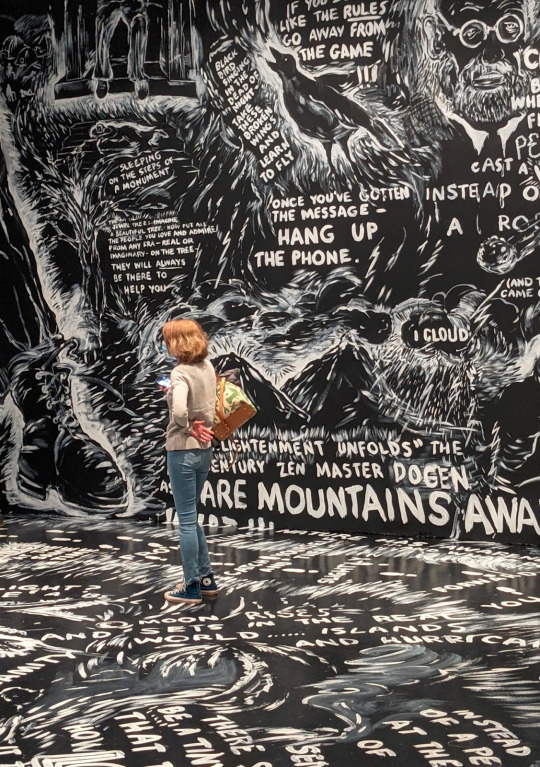
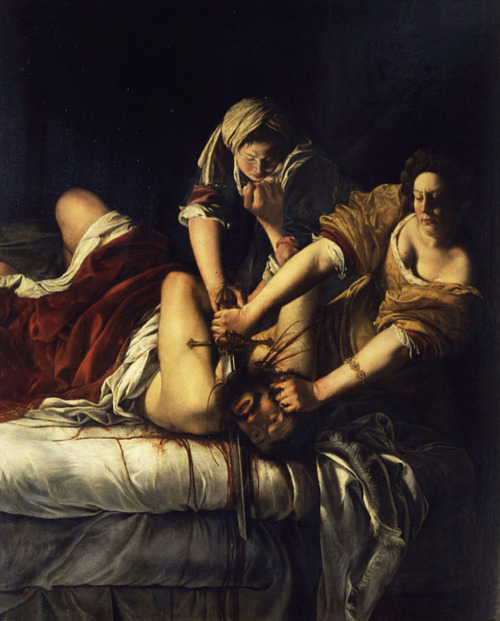
"The Weather" (exhibited September 24, 2021 – August 7, 2022 - Laurie Anderson) / "Judith Slaying Holofernes" (c. 1620 - Artemisia Gentileschi)
THE WEATHER: This is the Laurie Anderson room at the Hirshhorn Museum in Washington, D.C. I think it used to be part of a larger exhibit but I only saw it recently and by then it was this one room. It’s hard to describe without being there — this huge black room covered in white paint. Drawings, words, on the walls and the floor. I kid you not, walking into that room felt like walking directly into my brain. The fragmentation, the poetry of it, it’s so crowded, bursting with cognition. Remembrances and stray ideas fly around this place and I stayed there for an hour plus, reading everything and looking at everything and sitting in the corner. It made me so insane I went home and wrote an entire prose poem about it. (green-cargaytions)
JUDITH SLAYING HOLOFERNES: i am in love with Caravaggio's works so this isnt 'hating' him or something. but i dont know how else to explain how absolutely brilliant artemisia's work is.
ok alright, so first off in (caravag)gio's works judith looks a little disgusted (?). like she looks as if she's distancing herself from the act. not only from her expressions, but also from the literal distance. it's as if she doesnt want the blood to 'contaminate' her.
as for arte(mis)ia's interpretation, she looks like she's immersed. the proximity, her expression (she seems determined and vindictive) and the grip she has on his hair is gfsdhjdgj
also i love how mis has portrayed the ladies to be physically strong. i adore the arms. they are bulky and i dont know it just seems physical strength.
also also the second woman is involved in the act if his beheading which just idk her interpretation creates such an intimate portrayal. it feels more immersive and powerful. i might be biased, but i feel like the lighting is spectacular too.
also, in gio's version, i feel myself dividing attention between judith and holofernes which creates a short distance in my mind, while in mis' version, all the subjects grab your attention at the same time.
artemisia has portrayed the struggle and resistance wayyyy better too (imo). pay attention to Holofernes' hands. he's trying to fend for himself. the grip judith has as she tries to counter his resistance. besides, notice the sleeve slipping off her outfit. like holy shit.
also did you notice one of her knee on the bed (just noticed as i am writing this and i am frothing at the mouth)
btw i am obsessed with the way mis has painted the bedding. idk the way light hits it, and honestly just the way she has painted it is pretty gorgeous. and also the fabrics, there is something in the way they have been painted.
the blood that spurts out of holofernes' neck is portrayed so 'realistically' in her interpretation too. the way it drips down the bedding.
ok so now if you pay close attention to the way the blood spurts, a string (?) of blood is parallel to judith's bracelet which appears to depict Artemis, which might be a small indication towards her putting herself in the place of judith. it is quite likely because-
(tw: rape)
-artemisia was raped at the age of 17. and she was tortured when she went to recount her experience which would prove her truthfulness (i want to go back in time and gauge their eyes out 🥰).
so not only was she raped, she was also publicly humiliated and this makes it even more likely for it to have been her spin on the mythology. (anonymous)
("The Weather" is an audiovisual exhibition by American artist Laurie Anderson. It was exhibited at the Hirshhorn Museum in Washington DC from September 24, 2021 – August 7, 2022, where it spanned the second floor.
"Judith Slaying Holofernes" is an oil on canvas painting by Italian artist Artemisia Gentileschi. It measures 6′ 6″ x 5′ 4″ (158.8 cm × 125.5 cm) and is located in the Uffizi Gallery in Florence.)
47 notes
·
View notes
Text

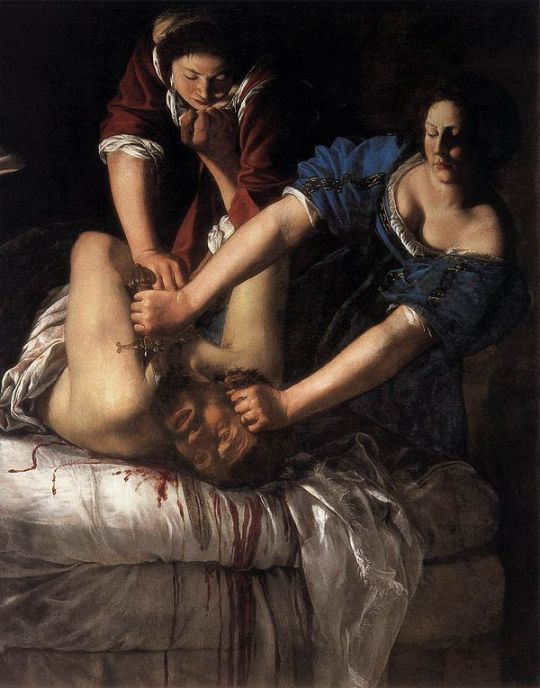
i listened to this episode of IOT on my commute home, and was struck dizzy by a comment made about artemisia gentileschi's painting judith slaying holofernes. apparently, when artemisia was a teenager, she was raped by another well known artist, agostino tassi. according to the academics in the episode, it is documented that artemisia claimed to have stabbed tassi following the encounter. it is also believed that the painting above, depicting the biblical figure judith beheading the general holofernes after seducing him (with her face, not sleeping with him), is a self-portrait, as much of artemisia's work was. she was so artistically obsessed with the subject that six known paintings by her depict it.
#i was just completely blown away. imagine living in 16/17th century europe and being practically the only celebrated female artist#you're violated in a way that was generally socially acceptable#(her father sued tassi - not for the rape but for dishonouring the family by not marrying her afterwards#)#and you paint the most beautiful painting of yourself as a chaste and holy biblical woman slaying a the figurehead of a conquering force#i feel dizzy
16 notes
·
View notes
Text
Fabric Study
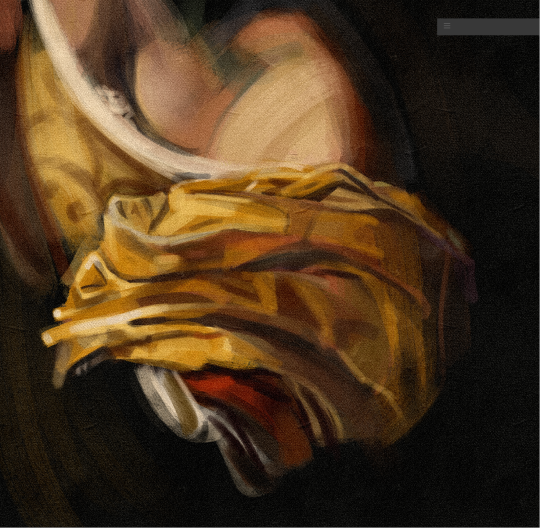
Taking a break from hammering on sequential art for something completely different.
Fabric shape and drapery isn’t among my current strong points—nor is digital painting frankly—so I figured I should really sit down and let my brain puzzle over it with a masters study. It feels like doing math. Hopefully less so, the more I keep doing it.
Picking the colors to match was a good exercise in color relativity. I liked how the original artist used pure black to outline and define the subject in the very darkest parts of the painting. It’s an interesting technique.
Studied (very inaccurately) from Judith Beheading Holofernes by Artemisia Gentileschi (1620)
#art study#and now for something completely different#digital sketch#artemesia gentileschi#digital art#my art#steelscorner#it’s the middle of the night#posting for the three people who might see this#hello insomniacs and/or people in other time zones
9 notes
·
View notes
Text
Subjectively Ranking Most 10 Controversial Artists and the work that enraged the art world: An ‘Ism’ Overview - Perspectives Comparing And contrasting art movements
Marcel Duchamp (1887-1968), Dadaism: His piece, "Fountain" (1917), a porcelain urinal, was seen as a challenge to the conventional notion of what art is and provoked a great deal of controversy.
Damien Hirst (1965- ), Young British Artists (YBA): Hirst's piece "The Physical Impossibility of Death in the Mind of Someone Living" (1991) featured a shark preserved in formaldehyde and received criticism for its perceived lack of artistic merit.
Pablo Picasso (1881-1973), Cubism: Picasso's painting "Les Demoiselles d'Avignon" (1907) was considered shocking due to its distortion of the human form and rejection of traditional perspective.
Jackson Pollock (1912-1956), Abstract Expressionism: Pollock's "drip paintings," such as "Number 1 (Lavender Mist)" (1950), were seen as chaotic and meaningless by some critics.
Gustave Courbet (1819-1877), Realism: Courbet's painting "The Origin of the World" (1866), a close-up of a woman's genitals, was considered pornographic and scandalous.
Edvard Munch (1863-1944), Expressionism: Munch's painting "The Scream" (1893) was seen as disturbing and nihilistic, reflecting the anxieties of modern life.
Francisco Goya (1746-1828), Romanticism: Goya's "The Third of May 1808" (1814) depicted a Spanish firing squad executing citizens during the Napoleonic Wars, challenging traditional heroic portrayals of war.
Kazimir Malevich (1878-1935), Suprematism: Malevich's "Black Square" (1915) was criticized for its rejection of representation and perceived emptiness.
Jeff Koons (1955- ), Contemporary Art: Koons' work, such as his series of sculptures depicting Michael Jackson and his pet monkey, was seen as crass and exploitative.
Caravaggio (1571-1610), Baroque: Caravaggio's violent and dramatic paintings, such as "Judith Beheading Holofernes" (1599-1602), were criticized for their graphic depictions of violence and lack of decorum.
2 notes
·
View notes
Text
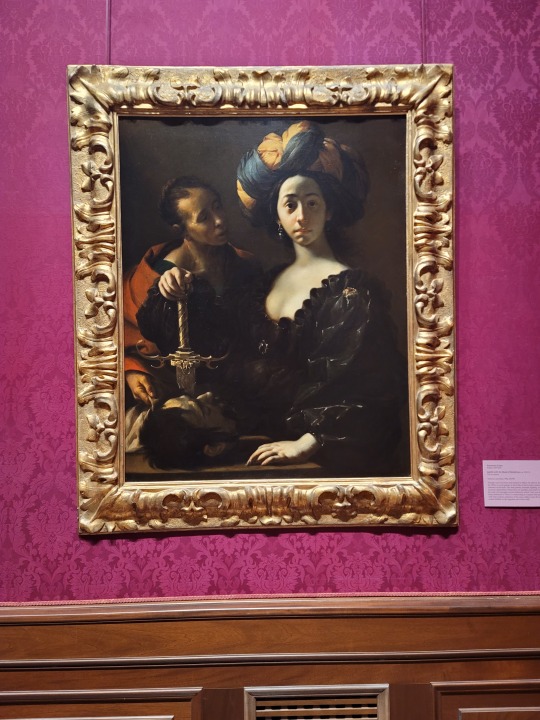


Francesco del Cairo’s Judith with the Head of Holofernes Analysis
This painting is, in one word…intense. Francesco del Cairo employed techniques from Morazzone to Il Cerano to Caravaggio with brilliant execution. Although this painting is based on a story with historical suspicions, its theme of Good vs. Evil and David vs. Goliath is timeless.
Situated on a canvas 46.5 x 37 inches, it is painted with oils and framed ornately. The frame neither adds or takes away from the painting, it merely adds definition to what Cairo has accomplished. The painting takes the style of Caravaggio with its subject, in this case Judith, bright and highlighted and the rest of the painting in shadow with dark and subdued tones. Judith is the obvious focus of this painting with the single light in the room enhancing her creamy, alabaster white skin against her black dress and shadowed surroundings. Her face, chest, bosom, and left hand immediately cry for your focus at first glance. Her face is, to me, the most interesting piece of the painting. One half in light, the other in shadow, it contains a mixture of emotion, from resoluteness to defiance to slight sympathy. Next to draw your focus is her vibrant blue and orange turban situated on her head, also benefiting from the one light in the room. After you breathe in Judith and her gorgeous turban, you notice the severed head of Holofernes on the table just in front of Judith in the lower left of the painting. Judith has the sword, assumingly used to commit the beheading, standing behind the center of the head with her hand grasped around the pommel of the hilt, a certain air of resolve in the grasp. The way the sword is situated behind the head, almost appears as if the sword is impaling the head after it has already been shorn from its body. Behind Judith’s right arm and sword, stands her servant, again, almost in shadow compared to her. The servant is an older woman, wrapped in a fire-orange shawl, hair braided and tight to her head, with her right hand holding a sheet or bag attempting to put it around the head. The servant looks at Judith with slight earnestness, maybe in an attempt to get Judith moving and away from where they are, for what they have done. The tilt of the servant’s head also has a sense of eagerness about it, Judith is focused and firm in what she has done and the servant is trying to draw her attention by bringing herself more into Judith’s view. The painting is very static and stoic in its lines, Judith’s arm and body aligning with that of the sword pommel in very rigid up and down lines. They create the main body of the painting with the servant behind one of them, reaffirming her secondary place in the painting. The painting maintains a sense of unity throughout with the use of dark tones and shadows. The use of variety in the skin and turban help to balance the unity in the painting.
At first glance, I’m taken away with Judith’s face. This is the only painting at Ringling that truly stood out to me, not only for its style, but mainly through Judith’s gaze. It carries a refined weight. Judith stands resolute and unwavering in the action she has taken. Before I researched the story of this painting, that drew me in. I didn’t know who she had beheaded or why she had felt the need to do so, but I knew she was probably on the right ‘moral side’ of the compass just from her gaze. There is no joy, happiness, ambition, or glee in her face. She has not enjoyed what she has done, but it needed to be done, it called to be done and she had stepped up to accomplish the task. Her servant seems to understand the reasoning behind her actions and seems to care for her, she wants to move Judith along and get her to safety before whatever ramifications come from the beheading. The servant doesn’t seem obligated in these gestures but sincere and wanting, which tells me they were most likely justified and necessary. I love the painting’s weight and moral compass, all visible just from looking and without any prior knowledge of the story.
This painting is the work of Francesco del Cairo and was made somewhere between 1633-1637. During this time, Cairo was employed as a court painter in Turin so it is safe to assume the court may have commissioned the painting. The time period tells us it is at the semi-beginning of the Baroque period so it is still influenced by the Renaissance but without a doubt employs the Baroque tendency towards drama and splendor. This painting depicts the Book of Judith, which relates the story of the Assyrian King, Nebuchadrezzer, who sent his General Holofernes to take the Jewish city of Bethulia. While under siege, Judith, a widow, went to Holofernes' tent and foretold him of his victory. He accepted Judith into his tent and after he put himself into a drunken stupor, Judith beheaded him with his own sword. She brought his head back to the city and a victory of the now leaderless Assyrian’s followed. The historical accuracy of the Book is called into question with dates, names, and places not quite lining up. It nevertheless tells the story of the triumph of good over evil and the need for faith in trying and stressful times. Cairo does an excellent job of showing us that Judith came to impress the general with her gown and elaborate turban, and after doing so standing firm in her actions. She did what was necessary for her faith and the people of her city. After looking over several paintings depicting a similar scene, this one tells the story in its truest form.
Given the genuine, yet slightly dramatic flair, this painting encapsulates the transition from Renaissance to Baroque painting. The painting still depicts an idealized event in scripture, yet adds the striking nuance of the painter and his feelings of the event. In the same style as Michelangelo Merisi da Caravaggio, Cairo creates a vivid and dramatic painting through the use of intense lighting and bold colors. The Book of Judith tells us of God’s will exerted through human’s to accomplish the right task, yet Cairo takes a spin on the divine message through Judith’s face. She may have done the task to fulfill her faithful duty, but she was the one who did it and she faces those facts dead on, unwavering. Cairo continues the style and work of Caravaggio, one of the Baroque period's most influential artists. This painting continues the transformation of style seen under the Baroque period and the transition the story telling takes, from one of wide reaching depictions of faith and religious splendor to that of a more personal and informal take on the same stories. This is evident most clearly in the subject matter from the start, Cairo showed an affinity for heroines in dramatic situations. This painting contributes strikingly to the transformation of art in the 1600’s and the continuation of the Baroque style.
Judith with the Head of Holofernes has had many interpretations depicted through the years; however, Francesco del Cairo has created a unified masterpiece with this creation. The painting is classic Baroque with a drama filled story, bold colors and generous use of shadows, as well as the artists own flair for heroines in scripture. I hold Baroque art in higher esteem and consider it a pivotal change in the transition of art from the Renaissance.
3 notes
·
View notes
Text
Artist research

As part of my artist research I've been looking into historic depictions of emotional women, especially women's rage since one of the pms emotions I'm focusing on is anger. here I've included Elisabetti Sirani's 'Timoclea kills the captain of Alexander the Great', Caravaggio's 'Judith beheading Holofernes' and on the same subject but with two different portrayals Artimisa Getileshki
4 notes
·
View notes
Text
Gentileschi and Galileo Were Pen Pals

Artemisia Gentileschi, Judith Slaying Holofernes (ca. 1614–20).
Some of the world’s greatest artists and thinkers have turned to each other for guidance and inspiration: Salvador Dalí and Sigmund Freud, Langston Hughes and Zora Neale Hurston, Paul Cézanne and Émile Zola.
But did you know that the painter Artemisia Gentileschi was pen pals with the astronomer Galileo Galilei?
The pair wrote back and forth, and in one famous letter in 1635, the artist asked the astronomer to speak kindly about her work to Duke Ferdinando Il de’ Medici—the Grand Duke of Tuscany—as he had done in 1620.
Gentileschi, the daughter of the artist Orazio Gentileschi, was one of the 17th century’s most important painters, far surpassing the reputation of her father.
She was the first woman ever to be admitted to the Academy of Design in Florence and also trained in her father’s studio.
In 1611, Gentileschi was raped by her father’s assistant Agostino Tassi, and was subjected to a humiliating and invasive trial which saw Tassi sentenced to a year in prison and exile.
Her painting Judith Beheading Holofernes (ca. 1614–20) is seen as Gentileschi’s “revenge piece”, with the artist herself in the role of Judith doing the graphic beheading of the Assyrian general.
Galileo was nearly 30 years Gentileschi’s elder, and is celebrated as the world’s first modern scientist.
He invented his own telescope, astrolabe, compass, and a precursor to the thermometer.
He made key discoveries about space including Jupiter’s four largest moons, the phases of Venus, and a breakthrough about the Milky Way.
The pair met in Florence while Galileo was working on his book Two New Sciences (1638), which discusses kinematics and the strength of materials, and they began exchanging letters.
Gentileschi sought Galileo’s advice for her second version of Judith Beheading Holofernes, and Galileo’s research on the parabolic law of projectiles—which would only be published almost two decades later—may well have impacted the way that Holofernes’ blood spurts from his neck in an arc in the later version of the painting.
In the first version, it runs down his neck onto the bedsheets.
A painting by Artemisia Gentileschi depicting a woman holding an urn while sitting on a cloud.
Artemisia Gentileschi, Allegory of Inclination (1615-16).
Galileo’s research shared what happens to cannonballs when fired, but the same physical laws could be applied to flying liquids.
As defended by historians David Topper and Cynthia Gillis in their 1996 paper Trajectories of Blood: Artemisia Gentileschi and Galileo’s Parabolic Path, and unless Gentileschi witnessed a real beheading for inspiration, it seems likely that Galileo was one of her key resources for making the second version of the painting more scientifically accurate.
When they first met, Galileo was the court mathematician and philosopher to the Grand Duke Cosimo II.
It was the duke who commissioned Gentileschi to create the replica of Judith, and Topper and Gillis explain that “when Artemisia received the commission from Cosimo II […] she drew on Galileo’s discovery for a realistic depiction of the splattering blood”.
Gentileschi’s Allegory of Inclination (1615) is also thought to include a nod to the pair’s friendship.
The painting’s nude figure holding a compass, which Galileo had invented a few decades earlier and which may also reference his research into magnetism, and the bright star in the sky is painted in a similar style to the way Galileo depicted stars in his 1610 paper The Starry Messenger, the very first published paper of observations made through a telescope.


0 notes
Link
0 notes
Text
May 12- Uffizi… oh wow
Uh… quite literally a very intense place to go to near the beginning of this program. So much to see, and so much absolutely fantastic things to gawk at like a fool…
I won’t lie, something about being inside places like this makes my heart swell. I have an insatiable urge for knowledge and something about art and history (imagine putting those together, what?!) that makes me absolutely writhe in every way possible. It’s not even a fully satisfiable, since I want to know everything. Every single little thing.
With that in mind, what an incredible place to get lost in. I would have stayed all day if time wasn’t so cruel. It’s hard for me to even pull out favorites, too, since it felt like no room was safe from me becoming giddy.
But I will pick a couple…
There is no lack of Annunciation scenes, but Leonardo’s is… gorgeous. My picture is lackluster and not good since those rooms were frustratingly packed full. However, the detail is absolutely insane up close. From the thinness of the veil draped along the book stand, to the softness of the landscape in the background, to the vibrancy of the clothing the figures are wearing, everything is working together to display this scene in the most striking way. And looking at the way he paints Gabriel’s gaze… so intense and purposeful. UGH!
Another… is Artemisia Gentileschi’s Judith Beheading Holofernes. Max, Ella, and I jumped up and down in a circle like a bunch of nerds when we came across it. That’s also why the image I took for reference, uh, looks the way it does. This painting is so fluid and full of action. I can almost hear it. The blood pouring and flying is telling of intense physical struggle, if the faces and bodies of the figures weren’t enough to tell you that. The contrast between the dark Caravaggio-esque background and the brightness of their clothing and the white sheets of the bed, make this scene really pop out at you. Also, seriously, that blood is literally insane.
In order:
1. Little dragon!
2. Water… details from Piero Del Pollaiolo’s Temperance, 1470
3. Up close details from Filippo Lippi’s Madonna and Child with Two Angels, 1460-1465
4. Do you think they’re twins or they just have the same face? A section from Botticelli’s Madonna of the Pomegranate, 1487
5. Cupid and Psyche, the subject of my text-adventure game that I made for one of my classes last semester!
6. Sooooo blue. Filippino Lippi’s Adoration of the Child, 1478-1480
7. Gabriel from Leonardo’s Annunciation, 1472-1475
8. The Virgin from Leonardo’s Annunciation, 1472-1475
9. Titian’s Venus of Urbino, 1534
10. Artemisia’s Judith Beheading Holofernes, 1612-1613










0 notes
Text
Judith Slaying Holofernes

Artemisia Gentileschi, Judith Beheading Holofernes (1620). Oil on canvas, 146.5 x 108 cm. Museo Capodimonte, Naples.
Artemisia Gentileschi's Judith Slaying Holofernes stands as one of the most vivid and dramatic works in the realm of Baroque painting, encapsulating themes of courage, justice, and female empowerment. This post delves into the artistic and symbolic nuances of Gentileschi’s iconic painting, offering a deep dive into its historical context, visual analysis, and enduring impact.
The Power and Fury: A Closer Look at Gentileschi's Masterpiece
Artemisia Gentileschi, born in 1593 in Rome, was one of the first women to achieve recognition in the male-dominated world of post-Renaissance art. Judith Slaying Holofernes is often viewed through the lens of Gentileschi's personal history, particularly her experience with sexual assault and the subsequent highly publicized trial. The painting, created in the early 1620s, is interpreted by many as a form of cathartic expression, showcasing her mastery over her traumas and her assailants.
The Art of Contrast: Tenebrism in Judith Slaying Holofernes
The painting depicts the biblical story of Judith, a widow who saves her village from the Assyrian general Holofernes by seducing and then beheading him. Gentileschi’s rendition is remarkable for its intense realism and emotional power. Unlike other contemporary versions of the subject, Gentileschi’s Judith appears strong and resolute in her task, capturing a moment of intense physical and psychological action.
Defiance in the Details: Symbolism in Gentileschi's Narrative
In Judith Slaying Holofernes, Gentileschi aligns herself with Judith, symbolically enacting a narrative of female agency and vengeance. This work is often read as a proto-feminist statement, with Judith’s act representing a broader defiance against patriarchal oppression. The painting challenges traditional gender roles and reflects Gentileschi's own struggles against the societal limitations imposed on women of her time.
Artemisia Gentileschi's Legacy: Reclaiming Space and Narrative
Artemisia Gentileschi's work has experienced a resurgence of interest in recent years, celebrated for its bold thematic content and its reflection of the artist's personal narrative of overcoming adversity. Judith Slaying Holofernes not only contributes to the historical narrative of art but continues to inspire discussions on gender, power, and resilience.
A Canvas of Courage: The Timeless Message of Judith Slaying Holofernes
Judith Slaying Holofernes by Artemisia Gentileschi is not just a depiction of a biblical heroine, but a profound commentary on justice, courage, and the capabilities of women both in art and in life. It remains a powerful image of defiance and autonomy, resonating with audiences centuries after it was painted.
Reflect and Engage
How do you think Judith Slaying Holofernes challenges or reinforces the perceptions of women both in the era it was painted and today? Does the painting's violent imagery detract from or enhance its message of female empowerment?
#ArtemisiaGentileschi#JudithSlayingHolofernes#BaroqueArt#FeministArt#ArtHistory#WomenInArt#PowerfulPaintings#ArtisticExpression#HistoricalArt#ArtAndResistance#artblogger
1 note
·
View note
Text
Visual Analyses at the Ringling
The piece I chose for my visual analyses is Judith with the Head of Holofernes by Fede Galizia. The artwork was painted in 1596. It is oil on canvas sized 120 x 94 cm. The piece uses rich, red jewel tones and intricate details in the bodice of the female subject, Judith. Galizia uses light hues to draw our eye to certain parts of the painting, specifically the left side where Judith is standing in front of a bright red curtain, and dark hues on the right side of the painting where her maid and a man’s severed head is.
When I first saw the work I was drawn to the beautiful woman with a white dress with beautiful details and jewels on the bodice. This work peaked my interest because I almost missed the fact that a man’s severed head is in the painting due to the dark colors Galizia used on that section.
Research told me Judith was a character within a story in the Book of Judith in the Apocrypha during the time period this was painted. She was supposedly a wealthy Jewish widow whose village was being attacked by the Assyrian Army led by its general, Holofernes (Vertefeuille). Holofernes had become taken with Judith and she used that advantage to gain access to Holofernes and eventually kill him by beheading to save her village.
The artwork was created towards the end of the Italian Renaissance, in 1596. It is a baroque style painting. Baroque style generally features deep colors, dramatic light, sharp shadows and dark backgrounds (Artland). This work definitely falls into those categories, with the way Galizia painted the right side with dark tones. Judith’s dress is so bright and dramatic which is what draws our eye to the painting to begin with. It is not known exactly who commissioned this piece, but the Book of Judith was a popular subject with private collectors and painters at that time.
I think this piece would resonate with both men and women at the time. Women saw Judith as a hero who saved her village even as a woman. Men saw this painting as a warning - not to lose your head over a woman (Vertefeuille). As far as its importance today – I think it’s another piece of the puzzle of the time period that is the Italian Renaissance. We can look at all the art together and get a sense of what a dramatic time period it was. Also, I think women can still look at this painting and be inspired by her heroism.
WORK CITED
Artland. (2023, April 18). Baroque: Art, definition & style of an era. Artland Magazine. https://magazine.artland.com/baroque-art-definition-style/
Vertefeuille, L. (2000). Judith with the Head of Holofernes. Judith with the head of Holofernes. http://ringlingdocents.org/judith2.htm

0 notes
Text
Repaint History: Reclaiming the Female Gaze in Art
by Cody Rooney
“Only men are capable of aesthetic greatness.” This acerbic sexist remark uttered by the late Brian Sewell, is perhaps one of the most controversial and illuminating to be made by an art critic in the contemporary era. Yet, the sentiment can be found throughout the tradition of art history dating back to its inception. Just ask anyone to think of three famous artists from any era, and the overwhelming majority of responses are all male.
Feminist art, seeking to tackle the rampant sexism in the creative industries, is becoming more and more prevalent as artists and women in power take a stand against the old guard of misogyny. Take the Guerilla Girls; feminist activist artists who wear gorilla masks in public and use facts, humor and outrageous visuals to expose gender and ethnic biases as well as corruption in politics, art, film, and pop culture. Using anonymity to their advantage they focus on issues of intersectionality, discrimination and human rights issues through hundreds of projects (posters, actions, books, videos, stickers) all over the world.

Courtesy guerrillagirls.com
Or Toronto’s very own feminist arts activists. Started by two Toronto entrepreneurs, RepaintHistory seeks to champion gender equality in art and in the process rewrite the history of women in art. The aptly titled startup which encompasses a fashion line, a creative community and educational talkback series, helmed by Pegah Kargar and Jessica Tan is tackling sexism with a specific goal in mind, to “bring recognition and awareness to forgotten female artists of the past through various mediums while supporting present and future artists to ensure this gap will not exist in the future.” Women in art have been criminally underrepresented and undervalued for centuries, lending a disproportionate and sexist disposition to the art world, #RepaintHistory looks to rectify that through raising awareness, visibility and support for past and future female artists.

Jessica Tan (Left) and Pegah Kargar (Right)
Kargar, who started the initiative after a having an epiphany about the disparity of representation for woman in art, in reflecting on it, maintains it is not so much that female artists were not producing great works in the past, as it is that history was simply written through a male gaze. “These women were very successful artists during their day, it’s just simply that they weren’t written into the history books.”
Artemisia Gentileschi is one such artist she mentions as being largely forgotten by history, having served as the inspiration for RepaintHistory. Kargar refers to her as “one of the most badass artists and pioneer feminists of the 17th century”, becoming one of the most sought after and accomplished painters in the Baroque period, and the first woman accepted into the Art Academy of Florence. The artists work oftentimes depicts visceral feminine rage, depicted specifically in one of her most famous paintings, Judith Slaying Holofernes (1612-1613), wherein two women behead a man. The painting is described as Artemisia’s fantasy depiction of her retaliation against the male violence she became subjected to, and a radical and rebellious statement of feminist autonomy in a time where misogyny was dangerously oppressive.
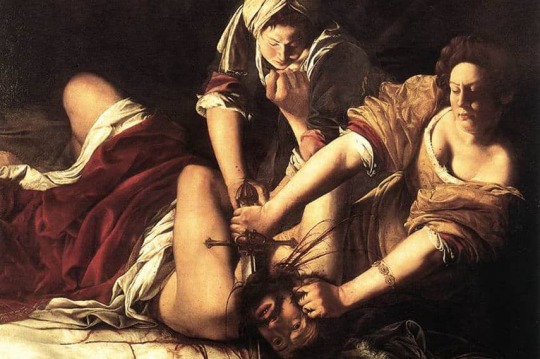
Judith Slaying Holofernes – Artimesia Gentileschi
Uncovering the female contemporaries of the canonical masters (Gentileschi was one of Caravaggio’s contemporaries), from the impressionists to the Baroque, is one of Repaint Histories mandates. One such way Repaint History seeks to increase the visibility of these artists, is through their very own line of clothing. Launched last year, Repaint History’s first release is a series of T-Shirts and Blouses juxtaposing the names of famed artists alongside their lesser-known female counterparts. Pegah hopes in creating this line that those wearing it will be walking billboards for the forgotten female masters. “By displaying these names beside each other we are looking to spark a conversation.”
The conversation for Repaint History does not stop at increasing visibility, it also looks at the many biases entrenched in the art world towards women, within the very fabric of its tradition. The startup is keen to make these biases known and rectified both stressing statistics as a form of factual data to display the disparities women face and the necessity for change. Pegah maintains that these material forms of data are a way to establish sexism in the art world as a very real and material problem. “When you see these statistics, it’s almost like you can’t deny that this is a serious issue… the proof is right there.”
For instance, a recent data survey of the permanent collections of 18 prominent art museums in the U.S. found that out of over 10,000 artists, 87% are male, and 85% are white, while women working across arts professions make almost $20,000 less per year than men. Pegah, however, remains optimistic that with increased visibility, the tides will begin to turn. “The more we talk about it, the more things will change… We will not stop until we see change.”
Coming off the cusp of their inaugural year, Repaint History has accomplished much in their first few months. In addition to Launching their Fashion Line; including a signature Blouse Collection, T-shirts, candles, and prints, Pegah and Jessica are finding other avenues to champion female visibility within the arts. They’ve hosted a series of Feminist Art Talkbacks including a packed evening at SOHO House Toronto as a prelude to the AGO’s “Impressionism in the Age of Industry” exhibition, and are actively collaborating with local female artists to raise awareness & funds. “We believe that it is not only important to give recognition to female artists of the past, but to ensure that we are supporting emerging female artists as well.”
1 note
·
View note
Text
10 Famous Gustav Klimt Paintings
Gustav Klimt was an Austrian painter who is known for his unique style, which combines elements of Art Nouveau and Symbolism. He is considered to be one of the most prominent figures of the Vienna Secession movement, which was a group of artists who sought to break away from traditional academic art and create a new style that reflected the modern world. Klimt's paintings are characterized by their ornate patterns, sensual figures, and use of gold leaf. In this article, we will take a closer look at 10 famous Gustav Klimt paintings.
The Kiss (1907-1908):
The Kiss is perhaps Klimt's most famous painting. It depicts a couple embracing in a field of flowers, with the man kissing the woman's cheek. The painting is known for its intricate patterns and use of gold leaf, which gives it a luminous quality. The Kiss is considered to be a masterpiece of the Art Nouveau style.
Adele Bloch-Bauer I (1907):
Adele Bloch-Bauer I is a portrait of a wealthy Viennese woman. The painting is notable for its use of gold leaf and intricate patterns, which are reminiscent of Byzantine art. The painting was the subject of a famous legal battle in the early 2000s, as it had been seized by the Nazis during World War II and was eventually returned to its rightful owner.
Portrait of Adele Bloch-Bauer II (1912):
This painting is another portrait of Adele Bloch-Bauer, but it is more abstract than the first. The background is made up of geometric patterns, and Adele's face is painted in a stylized manner. The painting is considered to be a masterpiece of the Art Nouveau style.
Judith and the Head of Holofernes (1901):
This painting depicts the biblical story of Judith, who beheaded the Assyrian general Holofernes to save her people. The painting is notable for its sensual depiction of Judith and its use of gold leaf. It is considered to be one of Klimt's early masterpieces.
Danaë (1907-1908):
Danaë is a painting of the mythological figure of the same name, who was the mother of Perseus. In the painting, Danaë is lying naked on a bed, and Zeus is depicted as a shower of gold. The painting is notable for its use of gold leaf and its sensual depiction of the female figure.
The Tree of Life (1905):
The Tree of Life is a painting that depicts a tree with swirling branches and leaves. The painting is notable for its intricate patterns and use of gold leaf. The tree is seen as a symbol of growth and life, and the painting is considered to be a masterpiece of the Art Nouveau style.
Medicine (1900-1907):
Medicine is one of three paintings that Klimt created for the University of Vienna's medical faculty. The painting depicts a group of figures, including a skeleton and a snake. The painting is notable for its use of symbolism and its striking colors.
Expectation (1905-1909):
Expectation is a painting of two women, one of whom is pregnant. The painting is notable for its use of gold leaf and its sensual depiction of the female figures. The painting is considered to be a masterpiece of the Art Nouveau style.
Beethoven Frieze (1901):
The Beethoven Frieze is a large-scale painting that was created for an exhibition in Vienna in 1902. The painting depicts various figures, including angels and the Greek goddess Athena. The painting is notable for its use of gold leaf and its intricate patterns
The Three Ages of Woman (1905):
The Three Ages of Woman is a painting that depicts the cycle of life. The painting shows a young woman holding a baby, an older woman, and a skeleton. The painting is notable for its use of gold leaf and its symbolic representation of the stages of life.
In conclusion, Gustav Klimt's paintings are renowned for their intricate patterns, sensual figures, and use of gold leaf. His unique style, which combined elements of Art Nouveau and Symbolism, has made him one of the most prominent figures of the Vienna Secession movement. From the famous painting of "The Kiss" to the Beethoven Frieze, Klimt's works continue to inspire and captivate art lovers all over the world. These ten paintings are just a small sample of his oeuvre, but they provide an insight into the beauty and complexity of Klimt's art.
Check out our website for buying exhibition posters and Paintings. Merch Fuse.
0 notes
Text
The Apocrypha: Hidden Gems of the Bible
youtube
The Apocrypha is a collection of books that are not included in the Hebrew Bible or the Protestant Old Testament. These books were written in the time between the Old and New Testaments and have been the subject of much debate among scholars and religious groups.
The word "apocrypha" comes from the Greek word "apokryphos" which means "hidden" or "obscure". The books that make up the Apocrypha were not considered part of the canon of scripture by the Jewish rabbis, but were accepted by some Christian groups.
The Apocrypha consists of 15 books, including Tobit, Judith, Wisdom of Solomon, Sirach (also known as Ecclesiasticus), Baruch, and First and Second Maccabees. These books cover a variety of topics, including history, wisdom literature, and apocalyptic prophecy.
One of the most well-known books in the Apocrypha is the book of Tobit, which tells the story of Tobit, a pious Jew who is exiled to Nineveh. Tobit is blinded by bird droppings and sends his son Tobias to retrieve some money that he has left with a relative. Along the way, Tobias meets the angel Raphael, who helps him to overcome various challenges and ultimately heals Tobit's blindness.
Another notable book in the Apocrypha is Judith, which tells the story of a widow who saves her city from the invading Assyrian army by seducing and beheading their general, Holofernes. The book of Judith has been the subject of many works of art and literature, including paintings by Caravaggio and Gustav Klimt and an opera by Vivaldi.
The Apocrypha also contains several books that are considered to be wisdom literature, including the book of Sirach. Sirach is a collection of proverbs and moral teachings, similar to the book of Proverbs in the Old Testament. It contains practical advice on how to live a good life and treat others with kindness and respect.
Despite their historical and literary significance, the books of the Apocrypha have been the subject of controversy among religious groups. Some Christian groups, such as the Roman Catholic and Eastern Orthodox Churches, include the Apocrypha in their canon of scripture, while Protestant groups generally do not. The reasons for this divide are complex and involve issues of theology, history, and language.
In conclusion, the Apocrypha is a collection of books that offer valuable insights into the history, literature, and wisdom of the Jewish and early Christian traditions. While their place in the canon of scripture may be a subject of debate, their impact on art, literature, and culture is undeniable.
Apocrypha #Bible #Jewish tradition #Christian tradition #history #literature #wisdom #controversy
0 notes